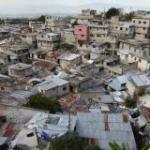Life in Mathare Slums- A documentary On Life In A Kenyan Slum
Raveena Aulikah – Climate Change Forcing Thousands in Bangladesh into Slums of Dhaka
thestar.com – February 16, 2013 -Raveena Aulakh
DHAKA, BANGLADESH—Taslima Masud faces a dilemma every morning: should she prepare food or stay hungry to avoid illness?
“The kitchen is so close to the toilet,” she says. “When I cook, I can’t smell the curry but I can smell the toilet. It disgusts me every day, but there is nothing I can do except . . . not cook. And I have to cook.”
Masud, 19, lives in Korail, Dhaka’s largest slum. Its roughly 70,000 residents dwell in the shadow of the affluent Gulshan neighbourhood, with its mansions, restaurants and western-style shopping centres.
Masud, her husband Mohammed, and their year-old daughter Karima share a one-room shanty that can be crossed in two strides. It is made of corrugated steel sheets held up by wooden poles. A bed takes up a large portion of the room and a battered TV sits in one corner. In another corner are Masud’s dishes. The kitchen, a cramped space with a couple of shelves, is in the back, about a metre from a toilet shared by two dozen other families.
Read more: http://www.thestar.com/climatechangebangladeshslumsdhaka.html
High-Tech Shack Brings Solar Power To Slums In South Africa
solarpanelreviewhw.com – From a distance, it is its shiny exterior that first catches the eye.
As you step closer, a rooftop solar panel, an outdoor security light and a roof overhang make Nosango Plaatjie’s shack stand out amid the sprawling cluster of makeshift wooden structures and rusty corrugated iron dwellings where her neighbors live.
Welcome to the iShack, or improved shack, an innovative approach to housing that’s being tested in the windswept slum of Enkanini, just outside Stellenbosch, South Africa.
The dwelling, developed by researchers at the University of Stellenbosch, is intended to raise the living standards of slum residents while improving their access to electricity and protecting them from extreme temperatures in an environmentally friendly way.
The iShack prototype is occupied by Plaatje and her three young children. It is fully equipped with a photovoltaic panel capable of producing enough electricity to power three lights, a mobile phone charger and an outdoor motion detector spotlight.
Its windows are strategically placed to achieve better air circulation and sunlight heating, while the roof is sloped so that rainwater can be harvested during the winter months.
Read more: high-tech-shack-brings-solar-power-to-slums-in-south-africa/
James Sofasonke Mpanza and Johannesburg’s Squatter Movement 1938 to 1947
www.sahistory.org.za. – The Natives Urban Areas Act of 1923 declared that blacks were temporary sojourners in urban areas and would only be permitted to reside there when employed. At the end of their working life they were to return to their homelands. The Act, intended to cover urban centres across South Africa, was rigorously applied by the Johannesburg Municipal Council (JMC). It provided the JMC with a legal basis to clear the inner city of what it considered insanitary areas. Between 1924 and 1931 the JMC issued eviction orders to blacks (individuals and families) residing in inner city slum yards to vacate these areas. These were contested in the courts, who ruled the eviction orders illegal if the JMC did not provide alternative accommodation to those affected.
Early in the 1930s, with the Great Depression lifting and the mining industry revitalized, the JMC was able to raise revenue to undertake a housing programme. This resulted in the establishment of Orlando Township in 1932. Slum clearance in the inner city of Johannesburg began in earnest in 1932 and was completed in 1937, when residents of Prospect Township were relocated to Orlando.
It soon became apparent that the number of houses provided by the JMC in Orlando was inadequate to cover all slum residents forced out of the inner city. Some sought accommodation in the freehold townships of the Western Areas. These included Sophiatown, Newclare and Martindale. Others opted to sublet in Orlando, becoming subtenants. The number of subtenants grew steadily in the second half of the 1930s, increasingly sharply during World War II.
Read more: James Sofasonke Mpanza and Johannesburg’s squatter movement 1938-1947
What Will Be The Long-Term Development Of The Population Of The German Reich After The First World War? – Introduction and Abstract
General Introduction
The 1920’s and 1930’s are among the most interesting periods in the history of modelling and forecasting. The continuous decline of Western birth rates in the inter-war period set alarm bells ringing. Concerns about the future size and growth of the populations of these nations were heightened by long-term extrapolations of time series, and by population projections and population forecasts. Concerns turned to acute anxiety after it became to appear that the leading Western European nations would not replace their populations. The imminent population decrease threatened to diminish the relative power of what were called in those days the ‘civilized’ nations and ultimaltely to result in ‘race suicide’ (the extinction of populations).
In some countries statisticians, demographers, or economists developed population projection methodology in order to free current debates on the population issue from emotional, subjective argument. In the two leading Fascist countries – but in other countries as well – population numbers were seen as the key to economic, political and military strenght. Read more
Phakamisa Ndzamela – Squeeze On Financing For Affordable Housing
bdlive.co.za – February, 06, 2013
The deteriorating creditworthiness and affordability among South Africans has affected the appetite for advance loans for affordable houses, according to Nedbank’s affordable-housing head Jeff Lawrence.
Among the worst affected were those earning between R3,501 and R15,000; they have been falling through the cracks when it comes to qualifying for mortgage finance.
To alleviate this problem, stakeholders need to come together to fully implement the government-initiated mortgage default insurance scheme and the finance-linked individual subsidy programme, which is meant to reduce the initial home loan amount to make the monthly instalments affordable, especially in the low-income market.
Mortgage default insurance is aimed at providing risk cover to commercial banks against clients defaulting on their mortgages.
The government hopes interventions such as these, which were announced by the National Housing Finance Corporation in late 2010, will encourage banks to increase lending for housing.
Read more: http://www.bdlive.co.za/business/property/2013/02/06/squeeze-on-financing-for-affordable-housing



